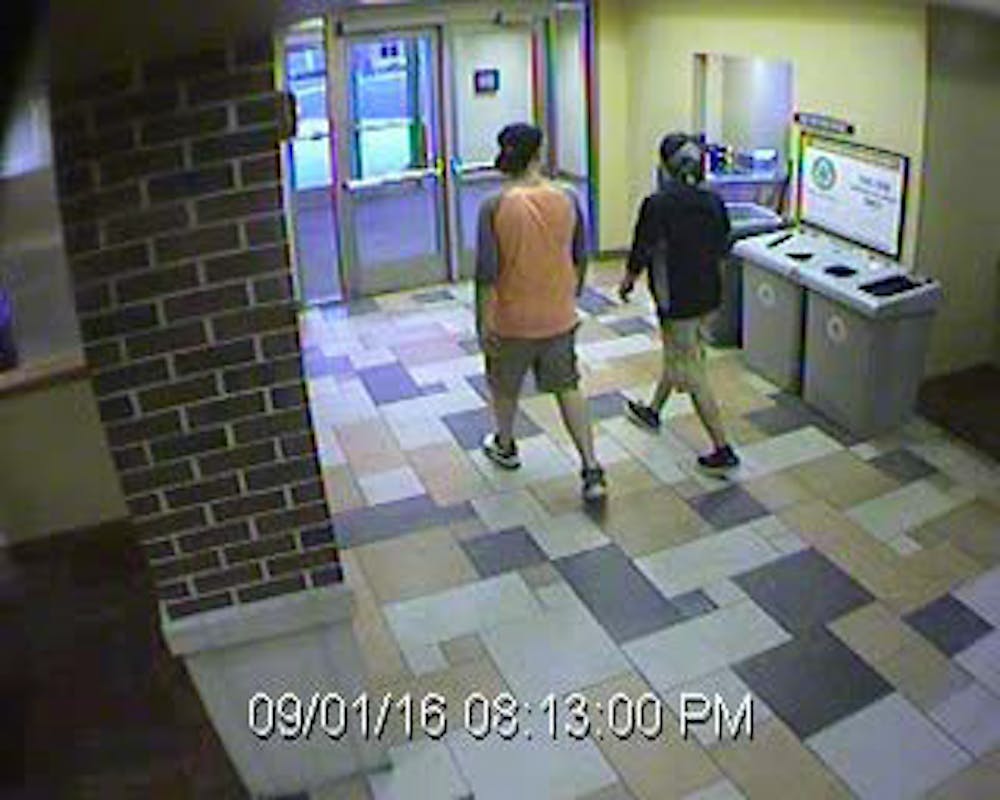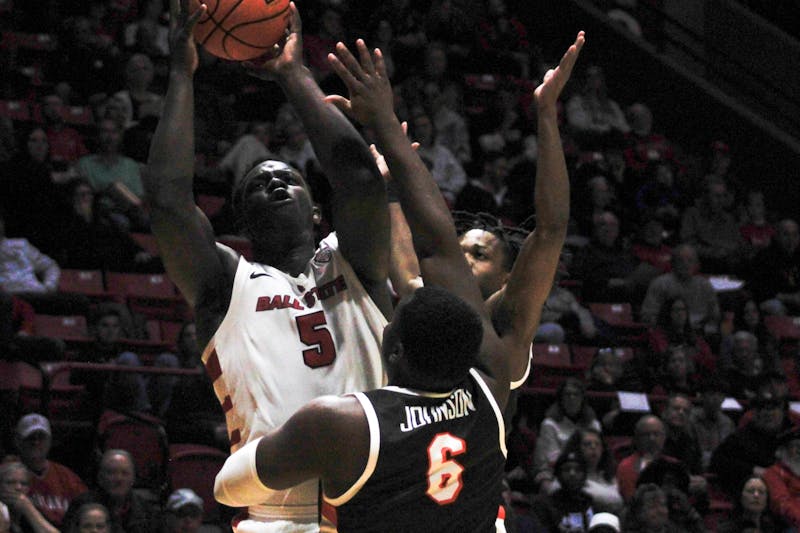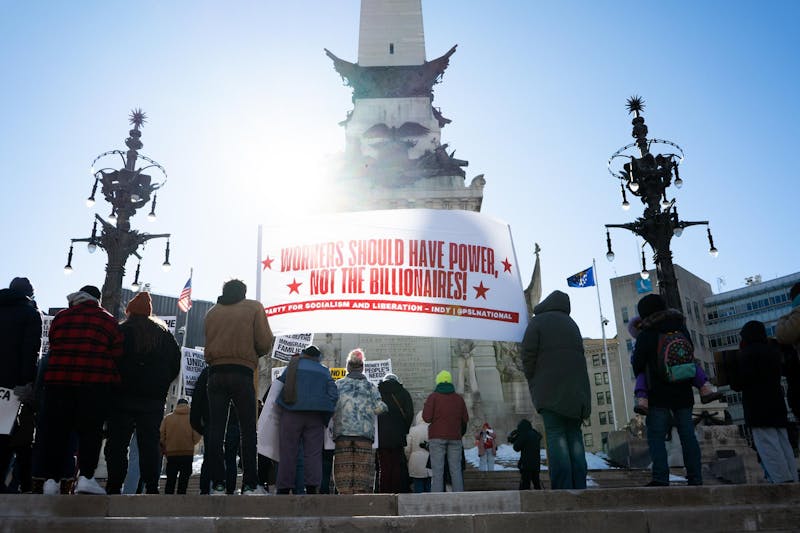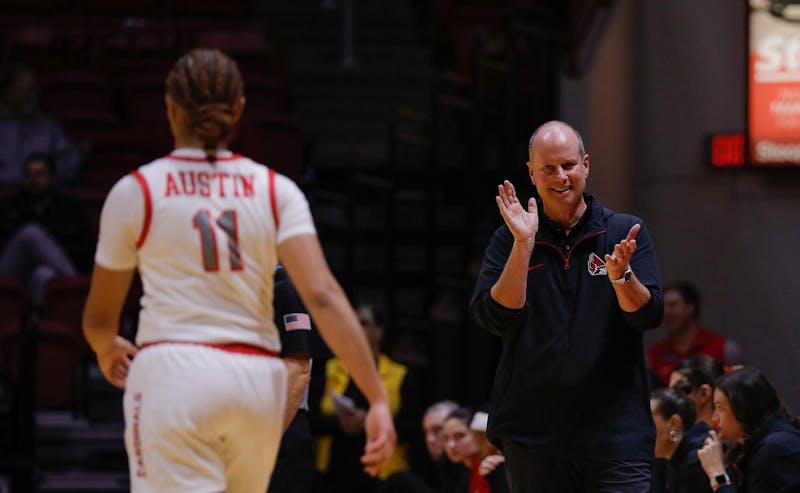Monday’s Ohio State University car-and-knife attack showed how important transparency and communication is during crises on campuses, which draws parallels and contrasts with Ball State's response to the Sept. 1 gun scare.
Ohio authorities said 11 people were injured when a man drove his car into a group of pedestrians on the Columbus campus, got out and then stabbed people with a butcher knife before police shot and killed the suspect.
How the Sept. 1 lockdown happened
It’s hard to know the whole story of what happened that night because Ball State has refused to release dispatch and police records.
Here’s what we know based on University Police Chief James Duckham's statement, Delaware County dispatch records and recordings of Muncie Police radio traffic:
8:14 p.m. — Ball State receives a call reporting “a subject with a gun,” according to Duckham’s statement. The “subject with a gun” walked into Woodworth Complex and university police were dispatched to the residence hall.
“The incident was not reported as an active shooter and UPD had no information that it was an active shooter incident,” Duckham said in an email.
However, the call came in as an armed assailant, initially, according to Muncie dispatch records and recordings of Muncie police radio traffic.
This initial call was inaccurate. It turns out that there were two suspects and one of them was carrying a gun. It’s unclear what the suspects were doing on campus. Surveillance video shows them in Woodworth for three minutes. Neither of the two suspects were students, Duckham said.
None of the records or statements indicate that a direct threat was made with the weapon.
“Those types of calls are really fluid. Every call is entirely different. When officers respond to those calls, they’re acting in real time,” Duckham said. “So, when we look at an incident … try to figure out things, it’s really easy to say, ‘Did you do this? Did you do that?’ It’s really hard when it’s happening. I can’t be more clear, that’s reality.”
8:27 p.m. — Ball State issues a shelter in place order. At about the same time, police learn that the suspect with the handgun "did not display" the weapon and is a white man with a pink shirt and tan shorts with a gun on his hip, according to police dispatch records released by the Delaware County.
At least 22 officers respond to the incident, which includes 14 from Ball State, eight from the Muncie Police Department and an unknown number of Indiana State Police officers. MPD and ISP assist UPD in the incident.
8:27 p.m. to 10:14 p.m. — Police search Woodworth for the suspects, interview several witnesses and view the Woodworth surveillance video. This is when police learn that there are two suspects, what they look like and that they left campus.
The surveillance video shows the suspects entering Woodworth on the DeHority Complex side at about 8:10 p.m. and leaving at 8:13 p.m. Neither suspect is running or displaying any signs of panic in the video.
8:45 p.m. — University sends out a notification stating, "Concerning man with a gun call."
8:54 p.m. — University sends out a notification stating, "Concerning the man with a gun."
9:02 p.m. — University sends out a notification providing the description of the suspects, which appears to come 30 minutes after it's marked down in the event log of Delaware County dispatch records.
9:24 p.m. — Police learn that the suspects might have left campus, obtain a possible vehicle description and learn the suspects were last seen 20 minutes ago heading eastbound toward the mall.
10:14 p.m. — The shelter in place order is lifted.
The next day, detectives followed up on leads and were able to identify the suspects. Upon interviewing both suspects, police decided no criminal charges would be filed and the suspects were banned from campus. It’s not clear why one of the suspects was carrying a weapon on campus other than he was a registered concealed carry holder.
Ohio police had few details initially, including what triggered the attack. Such gaps are common in the immediate aftermath of an incident, where details slowly come out in the ensuing days. But at Ball State, officials have refused to release records about the school’s gun scare even months afterward. The university released a comprehensive statement about the incident nearly two months after the lockdown.
Ohio and Ball State both provided numerous updates throughout their respective incidents.
Public records and an October statement from the university indicate an actual threat with a firearm may have never happened, just that two suspects were seen in Woodworth Complex, and one was carrying a handgun. Surveillance video from the incident – which cost the Daily News $288 to obtain through records requests – indicates the suspects spent just three minutes in Woodworth. Dispatch records indicate that the person with the gun “did not display” it at anyone.
Another unclear factor is the suspects had no apparent reason for being on campus or for carrying a handgun on campus. The suspect with the firearm did have a permit to carry, University Police Chief James Duckham said in an interview.
“The witness that we spoke to at length had the impression that he showed it to her. He displayed it in the sense that [he] moved his clothing so she could see it,” Duckham said.
To Duckham’s understanding, the suspect never pointed the weapon at anybody.
Indiana law does not regulate concealed or open carrying with a permit in public, Eric Hoffman, Delaware County chief deputy prosecutor, said. It is illegal to carry without a permit.
It’s against university policy for people to carry weapons on campus, regardless if they have a license to carry. No arrests or charges occurred in this case because police didn’t have “any sense that there was criminal intent,” Duckham said.
However, the suspects have been banned from campus. Neither of them were students.
Duckham said in an email statement to the Daily News that the incident was not reported as an active shooter threat.
The University Police Department has trained for active shooter incidents and is prepared for emergencies on campus, Duckham said. The university conducts training events throughout the year with assisting agencies like Muncie, Delaware County and Indiana State Police.
Ball State did make available the police department’s internal policy and field manual for handling crisis situations, which detail the command structure the university uses in response to emergency situations, like bomb threats and active shooters, and the checklists and procedures officers in the field follow.
But without knowing basic details of the September gun scare, it’s difficult to know how the department responded and whether its preparations worked. A number of questions remain unanswered, including:
- What were the original 911 caller’s exact words?
- What was the tone of the original call? Was it panicked or calm?
- What accounts did witnesses provide to police about what they saw that night?
- How exactly did
police find the suspects? - What questions did police ask the suspects and what did the suspects say?
An overall picture of that September night remains fuzzy because Ball State refused to release public records key to understanding what spurred on a campus-wide lockdown, although university officials were available for questions. They refused to release police records, like the original 911 call, event transcripts, radio traffic audio and the second and third pages of the police report. University Police did not produce an official report about how it responded to the incident or conduct a formal review of its policies.
Indiana law allows police to withhold public records if they are used, or “compiled,” in the investigation of a crime, regardless if the case is ongoing, closed or no arrests were made. This is called the investigatory records exception.
“[The exception] doesn’t mandate that they keep those records confidential. It just gives them the discretion to keep them confidential,” said Steve Key, executive director of the Hoosier State Press Association. “It’s a choice they’re making. The law isn’t requiring them to keep the information secret.”
Dispatch records – 911 calls, event transcripts and radio traffic audio – fall under this rule because of the use of the word “compiled” in the state law, according to a series of advisory opinions issued by Indiana Public Access Counselor dating back to 2007.
These opinions don’t enforce the law. But, they can be used in a lawsuit to either argue for the withholding or release of records. The public access counselor has repeatedly ruled on the side of law enforcement with the release of dispatch records. The Delaware County Emergency Management Center, which handles 911 calls made to Muncie Police and the Delaware County Sheriff’s Office, did release dispatch records.
“The position of the PAC has been pretty consistent in that area, giving the institution, or whoever the public records agency is, the discretion to not disclose those investigatory records,” said Melissa Holloway, deputy general counsel for Ball State.
The university’s choice to not release 911 calls, dispatch transcripts and police radio traffic stems from security and tactical concerns, Holloway said.
“But, I think ultimately in this instance ... there is strategic and tactical decisions and other things that happen in the part of a 911 call or are part of a dispatch record that we felt was appropriate to withhold in this circumstance,” Holloway said.
|
How the Sept. 1 lockdown happened It’s hard to know the whole story of what happened that night because Ball State has refused to release dispatch and police records. Here’s what we know based on University Police Chief James Duckham's statement, Delaware County dispatch records and recordings of Muncie Police radio traffic: 8:14 p.m. — Ball State receives a call reporting “a subject with a gun,” according to Duckham’s statement. The “subject with a gun” walked into Woodworth Complex and university police were dispatched to the residence hall. “The incident was not reported as an active shooter and UPD had no information that it was an active shooter incident,” Duckham said in an email. However, the call came in as an armed assailant, initially, according to Muncie dispatch records and recordings of Muncie police radio traffic. This initial call was inaccurate. It turns out that there were two suspects and one of them was carrying a gun. It’s unclear what the suspects were doing on campus. Surveillance video shows them in Woodworth for three minutes. Neither of the two suspects were students, Duckham said. None of the records or statements indicate that a direct threat was made with the weapon. “Those types of calls are really fluid. Every call is entirely different. When officers respond to those calls, they’re acting in real time,” Duckham said. “So, when we look at an incident … try to figure out things, it’s really easy to say, ‘Did you do this? Did you do that?’ It’s really hard when it’s happening. I can’t be more clear, that’s reality.” 8:27 p.m. — Ball State issues a shelter in place order. At about the same time, police learn that the suspect with the handgun "did not display" the weapon and is a white man with a pink shirt and tan shorts with a gun on his hip, according to police dispatch records released by the Delaware County. At least 22 officers respond to the incident, which includes 14 from Ball State, eight from the Muncie Police Department and an unknown number of Indiana State Police officers. MPD and ISP assist UPD in the incident. 8:27 p.m. to 10:14 p.m. — Police search Woodworth for the suspects, interview several witnesses and view the Woodworth surveillance video. This is when police learn that there are two suspects, what they look like and that they left campus. The surveillance video shows the suspects entering Woodworth on the DeHority Complex side at about 8:10 p.m. and leaving at 8:13 p.m. Neither suspect is running or displaying any signs of panic in the video. 8:45 p.m. — University sends out a notification stating, "Concerning man with a gun call." 8:54 p.m. — University sends out a notification stating, "Concerning the man with a gun." 9:02 p.m. — University sends out a notification providing the description of the suspects, which appears to come 30 minutes after it's marked down in the event log of Delaware County dispatch records. 9:24 p.m. — Police learn that the suspects might have left campus, obtain a possible vehicle description and learn the suspects were last seen 20 minutes ago heading eastbound toward the mall. 10:14 p.m. — The shelter in place order is lifted. The next day, detectives followed up on leads and were able to identify the suspects. Upon interviewing both suspects, police decided no criminal charges would be filed and the suspects were banned from campus. It’s not clear why one of the suspects was carrying a weapon on campus other than he was a registered concealed carry holder. |





The Daily News welcomes thoughtful discussion on all of our stories, but please keep comments civil and on-topic. Read our full guidelines here.